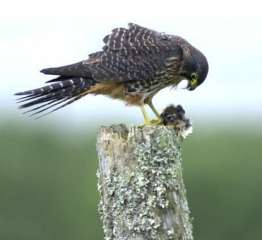The study took advantage of a conservation project called Falcons for Grapes, which was begun in 2005 to help revive populations of the threatened New Zealand falcon--the country's only remaining endemic bird of prey. Juvenile falcons (Falco novaseelandiae) are relocated from their natal grounds in the mountains to vineyards in Marlborough, New Zealand's largest wine-growing region. The researchers hypothesized that, once there, the falcons might help minimize damage to grape (Vitis vinifera) crops by preying on and/or scaring off pest birds. This includes 3 invasive species that eat grapes whole--the blackbird (Turdus merula), the song thrush (Trudus philomelos), and the starling (Sturnus vulgaris)--and one native species (the silvereye, Zosterops lateralis) that pecks holes into the grapes and makes them susceptible to fungal infections.
(New Zealand falcon, Falco novaseelandiae, a bird that has been described as "utterly fearless.")
During the 2-year study, the researchers surveyed 6 vineyards where falcons were introduced, and 6 where they were absent. Falcons are not native to the Marlborough area, so the researchers did not expect any of these birds to be sighted at their control sites. But, just to be sure, they trained field workers to identify the New Zealand falcon and asked them to report any that were observed during the study period; none were. At the introduction sites, the scientists performed bird surveys on a weekly basis in order to identify which pest species were present. They also measured grape damage and removal, estimating not only how many grapes were impacted, but also what these losses cost the viticulturists. Finally, the researchers used a 0-5 scale to quantify the non-falcon-related bird-scaring methods (including visual and auditory deterrents and hunting) used by the farmers to keep pest animals away from their grapes.
(A vineyard in scenic Marlborough, New Zealand)
In comparison to control vineyards, falcon vineyards had significantly fewer song thrushes and blackbirds (78.4% and 82.5% less, respectively), and markedly fewer (79.2%) starlings. Among interior vines, song thrushes and silvereyes were significantly less common (70.5% and 95.2%, respectively). However, starlings were significantly more common (57.7%); this is probably related to this species' tendency to prefer open areas during times of uncertainty, since these spaces allow the flock to look out for predators and other signs of danger.
(A silvereye, Zosteros lateralis, which damages vineyard grapes by pecking holes into them)
At both the edge and interior of vineyards, there was significantly less grape tampering: Fewer grapes were removed from bunches, and fewer grapes were pecked. Among edge vines with Sauvignon Blanc grapes, for example, removal rates were 0.6% at control vineyards, but 0.03% at falcon vineyards; peck rates were 2.3% at control vineyards, but only 1.0% at falcon vineyards. Overall, viticulturists at control sites lost approximately $819/ha across both their Sauvignon Blanc and Pinot Noir crops combined; on the other hand, cumulative losses only amounted to $259 at falcon vineyards.
(A blackbird, Turdus merula--one of several songbird species that steal grapes at vineyards)
Because of the relatively small size of the Falcons for Grapes program, the researchers were not able to sample many vineyards. However, they surveyed several vineyards where the raptors were present in one year and absent in the other; shifts in damage/removal rates echoed the patterns observed across the rest of their study, indicating that the birds really do help keep out pest species. This is probably due to direct predation--eating the offending animals--as well as simply scaring them off by making the whole neighborhood a more dangerous, and therefore undesirable, place to spend time.
Interestingly, the authors did not find a significant relationship between grape removal/damage levels and the traditional forms of bird-scaring strategies. This is likely because the pest birds quickly habituate to these stimuli, which (with the exception of hunting) generally cause them no harm. Falcons, on the other hand, are always a threat. Although more studies are needed to examine the long-term viability of the Falcons for Grapes initiative for both the raptors and their human hosts, it would appear that this is a win-win scenario--with benefits that spread all the way to your wine cellar.
---
For supplementary photos associated with this post, please visit the Anthrophysis pin board at Pinterest.
Kross, S.M., Tylianakis, J.M., Nelson, X.J. 2011. Effects of introducing threatened falcons into vineyards on abundance of Passeriformes and bird damage to grapes. Conservation Biology, online advance publication.
Thanks to the following websites for providing the images used in this post:
http://www.nzbirds.com/birds/falcon.html
http://www.concierge.com/travelguide/nz_southisland/seeanddo/18722
http://www.treknature.com/gallery/Oceania/New_Zealand/photo23808.htm
http://en.wikipedia.org/wiki/File:Blackbird_2.jpg




No comments:
Post a Comment